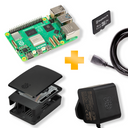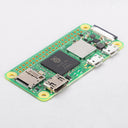Inky Impression
by Pimoroni
Beautiful, colour E Ink® / ePaper displays for use with Raspberry Pi computers. Available in 7.3” (800 x 480 pixel) and 13.3” (1600 x 1200 pixel) sizes.
Our Inky Impression E Ink® displays are super crisp, low power and look great from a variety of viewing angles. They have high pixel density and bright vivid colours, perfect for showing off gorgeous dithered images (we've put a lot of effort into our dithering code and we hope you love it).
Inky Impression also includes:
- The appropriate hardware to attach to your Raspberry Pi computer and fix it securely in place. If your Pi has a 40 pin header attached, you won't need to do any soldering.
- Four rear mounted buttons, for interacting with the screen.
- Two Qw/ST connectors, so you can easily connect up breakouts and other I2C devices.
Tell me about E Ink®!
Multi-colour EPD displays use electrophoresis to pull coloured particles up and down on the display. The coloured particles reflect light, unlike most display types, meaning that they're visible under bright light. They don’t use a backlight like LCDs do, so they’re easy on the eyes and don’t introduce unwanted light into your environment.
Electronic paper displays only consume power whilst they're refreshing, so they're a great choice for projects like home automation dashboards and electronic photo frames that need to be always on. They take a little while to refresh, so are best suited to projects that don't require constant screen updates.
What is the 2025 / Spectra 6 Edition?
A new generation of ePaper is coming and we’re so excited! 2025 Edition uses a new Spectra 6 E Ink® display panel which brings a number of improvements over the panels that we’ve used previously - notably a shorter refresh time and more saturated colours. It also comes in an extended range of sizes, so we’ve been able to make a huge 13.3” (1600 x 1200 pixel) version - that’s almost A4 size!
Features
- 7.3” (800 x 480 pixel) or 13.3” (1600 x 1200 pixel) ePaper display
- E Ink Spectra 6® technology
- Ultra wide viewing angles
- Ultra low power consumption
- Four rear mounted buttons
- M2 mounting holes at the corners
- 40-pin extension header included to boost height for full-size Raspberry Pi.
- Standoffs included to securely attach to your Pi
- 2x Qw/ST (Qwiic/STEMMA QT) connectors for adding breakouts
- Expansion header for adding other hardware
- Compatible with all 40-pin header Raspberry Pi computers, including Zero variants.
- Python library
- Comes fully assembled, with no soldering required (as long as your Pi has a 40-pin header attached).
The display is securely stuck down to the Inky Impression PCB and connected via a ribbon cable, and it comes with mounting hardware to attach your Raspberry Pi securely in place. Just pop Inky Impression on your Pi and run our installer to get everything set up!
Software
Our Python library takes the stress out of displaying text and images on Inky Impression. Check out our Learn guide for a beginner friendly introduction:
Tech Specs
| Product Name | Inky Impression 7.3” | Inky Impression - 7.3” (2025 Edition) | Inky Impression - 13.3” (2025 Edition) |
| SKU | PIM667 | PIM773 | PIM774 |
| Resolution | 800 x 480 pixels | 800 x 480 pixels | 1600 x 1200 pixels |
| Technology | E Ink Gallery Palette® | E Ink Spectra 6® | E Ink Spectra 6® |
| Colours | 7 (black, white, red, green, blue, yellow, orange) | 6 (red, green, blue, yellow, black, white) | 6 (red, green, blue, yellow, black, white) |
| Dot Pitch (mm) | 0.20 x 0.20 | 0.20 x 0.20 | 0.169 x 0.169 |
| Aspect Ratio | 5:3 | 5:3 | 4:3 |
| Pixels Per Inch (PPI) | 127 | 127 | 150 |
| Board Dimensions (mm) | 170.2 x 111.2 (W x H) | 174.2 x 123.2 (W x H) | 297 x 210 (W x H) |
| Usable Area Dimensions (mm) | 160 x 96 (W x H) | 160 x 96 (W x H) | 270.40 x 202.80 (W x H) |
| Refresh Time | ~40 seconds | ~12 seconds* | ~12 seconds* |
| Recommended Temperature | 15 ~ 35°C | 0 ~ 50°C | 0 ~ 50°C |
| Schematic | Link | Link | Link |
| Dimensional Drawing | Link | Link | Link |
Notes
- The Inky Impression display is made from glass so it's pretty fragile. Be careful not to drop it or press too hard on it, or it will crack. When fitting it to your Pi, grip at the edges of the board rather than pressing on top of the screen.
- This is not a touchscreen!
- The Inky Impression 7.3” board size is 174 x 123mm, which fits conveniently within a 180 x 130mm Ikea picture frame (though not with the screen perfectly centred).The Inky Impression 13.3” board size is 297 x 210mm, so it should be possible to install it in A4 sized picture frames.
- * The display manufacturer advertises the core refresh time as ~12 seconds at 25°C - 50°C - cooler temperatures may make the refresh take longer. It also takes a few seconds for the display to report a ready state and for data to be sent from the Raspberry Pi over SPI. A complete 'real world' refresh cycle is likely to take around 20-25 seconds.
- Inky Impressions made from November 2025 onwards have rear mounted buttons instead of side mounted ones. This should hopefully help resolve issues with the buttons getting knocked off during transit!
-
7.3" (2025 Edition)
PIM773£66.25 -
13.3" (2025 Edition)
PIM774£191.25
Inky Impression extras
You'll need a Raspberry Pi to plug it into!
-
 Raspberry Pi 5 Starter Kit+ £104.50
Raspberry Pi 5 Starter Kit+ £104.50 -
 Raspberry Pi Zero 2 W+ £12.00
Raspberry Pi Zero 2 W+ £12.00
Shop with confidence – we've been serving the hobbyist electronics, Maker, and retro gaming communities since 2012.
- Satisfaction or refund guarantee
- Worldwide shipping via mail or courier
- 57,000+ customer reviews
- Secure website and payments


